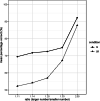The role of spatial information in an approximate cross-modal number matching task
- PMID: 36720781
- PMCID: PMC9888741
- DOI: 10.3758/s13414-023-02658-9
The role of spatial information in an approximate cross-modal number matching task
Abstract
The approximate number system (ANS) is thought to be an innate cognitive system that allows humans to perceive numbers (>4) in a fuzzy manner. One assumption of the ANS is that numerosity is represented amodally due to a mechanism, which filters out nonnumerical information from stimulus material. However, some studies show that nonnumerical information (e.g., spatial parameters) influence the numerosity percept as well. Here, we investigated whether there is a cross-modal transfer of spatial information between the haptic and visual modality in an approximate cross-modal number matching task. We presented different arrays of dowels (haptic stimuli) to 50 undergraduates and asked them to compare haptically perceived numerosity to two visually presented dot arrays. Participants chose which visually presented array matched the numerosity of the haptic stimulus. The distractor varied in number and displayed a random pattern, whereas the matching (target) dot array was either spatially identical or spatially randomized (to the haptic stimulus). We hypothesized that if a "numerosity" percept is based solely on number, neither spatially identical nor spatial congruence between the haptic and the visual target arrays would affect the accuracy in the task. However, results show significant processing advantages for targets with spatially identical patterns and, furthermore, that spatial congruency between haptic source and visual target facilitates performance. Our results show that spatial information was extracted from the haptic stimuli and influenced participants' responses, which challenges the assumption that numerosity is represented in a truly abstract manner by filtering out any other stimulus features.
Keywords: Haptics; Multisensory processing; Visual perception.
© 2023. The Author(s).
Conflict of interest statement
The authors have no competing interest to declare.
Figures




Similar articles
-
Get in touch with numbers - an approximate number comparison task in the haptic modality.Atten Percept Psychophys. 2022 Apr;84(3):943-959. doi: 10.3758/s13414-021-02427-6. Epub 2022 Jan 21. Atten Percept Psychophys. 2022. PMID: 35064556 Free PMC article.
-
Evidence for an A-Modal Number Sense: Numerosity Adaptation Generalizes Across Visual, Auditory, and Tactile Stimuli.Front Hum Neurosci. 2021 Aug 11;15:713565. doi: 10.3389/fnhum.2021.713565. eCollection 2021. Front Hum Neurosci. 2021. PMID: 34456699 Free PMC article.
-
[Mechanisms of cross-modal priming between visual and haptic modalities].Shinrigaku Kenkyu. 2003 Dec;74(5):452-9. doi: 10.4992/jjpsy.74.452. Shinrigaku Kenkyu. 2003. PMID: 15029762 Japanese.
-
Visual, haptic and cross-modal recognition of objects and scenes.J Physiol Paris. 2004 Jan-Jun;98(1-3):147-59. doi: 10.1016/j.jphysparis.2004.03.006. J Physiol Paris. 2004. PMID: 15477029 Review.
-
Multisensory object representation: insights from studies of vision and touch.Prog Brain Res. 2011;191:165-76. doi: 10.1016/B978-0-444-53752-2.00006-0. Prog Brain Res. 2011. PMID: 21741551 Review.
References
MeSH terms
Grants and funding
LinkOut - more resources
Full Text Sources

